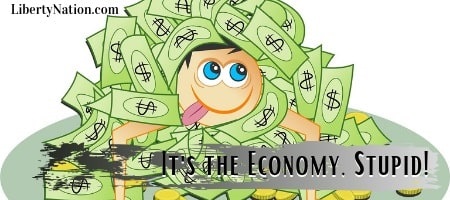How did Harry Houdini make an elephant vanish in front of an audience? Misdirection. In the great stock market bubble of 2020, Federal Reserve Chair Jerome Powell borrowed Ben Bernanke’s helicopter and dropped piles of cash at the headquarters of Wall Street’s titans without anybody noticing. While the business media talking heads are slamming armchair investors for pouring dumb money into bankrupt companies and beating hedge fund money managers, their attention has been diverted from the U.S. central bank bailing out Corporate America. Should we party like it is 2008? If so, it is time to believe in hope and change again and prepare to lose brain cells from the Twilight cinematic abomination.
Time to Bail
The Federal Reserve surprised financial markets in April when it announced it would purchase $750 billion in corporate debt through exchange-traded funds (ETFs). Two months later, the Eccles Building could not stomach the 10% drop in the stock market and expanded this mandate by buying individual corporate bonds. The purpose behind the bailout was to allow companies to focus on keeping workers employed, growing their businesses, and doing their part in supporting the recovery.
When the Fed launched the unprecedented program, you would never have thought that it would involve bailing out the nation’s largest corporations – again. Well, here we are. It turns out that the U.S. central bank has been bailing out both Wall Street’s juggernauts and the largest companies in the world.
According to a recent disclosure of transactions by the Fed, the Powell Putsch bought $428 million in bonds offered by household names in the first half of June. Walmart, AT&T, Philip Morris International, United Health Group, and Ford were just some of the brands. It also made investments in a utility subsidiary of Warren Buffett’s Berkshire Hathaway holding company.
The Fed noted that these acquisitions represented a fraction of the nearly 800 issuers whose bonds were eligible for purchase. But it also tossed $5.3 billion at more than a dozen corporate bond ETFs that inevitably included multi-billion-dollar companies.
Last month, the Fed parked $326.3 million in the iShares iBoxx U.S. Dollar Investment Grade Corporate Bond ETF. Why is this important? Some of the fund’s most significant holdings are bonds sold by the Bank of America, Goldman Sachs, JPMorgan Chase, and Wells Fargo. It might not be as big a bailout as in 2008, but the Fed is still allocating freshly printed banknotes to these institutions.
It is one thing extending a lifeline to struggling mom-and-pop shops. But rescuing America’s biggest businesses that have installed a revolving door between their companies’ front entrances and the government should be generating more handwringing. Life is all about priorities, people! Did you not know that the faces of Aunt Jemima’s maple syrup and Uncle Ben’s rice products were the most pressing issues of the day? For shame.
Waltzing for MMT
 Should Apple and Visa receive a cash injection from the Federal Reserve? These are some of the most lucrative stock tickers in global financial markets today, leading critics to wonder if this is the best way to prioritize the newly created money from the printing press inside the vaults of the Eccles Building. The Fed’s bobby-soxxers would dismiss the criticism by pointing out that the Powell Putsch involves helping Main Street as well. This might be a valid defense if the Fed had been dishing out funds from its $2.3 trillion Main Street Lending Facility, but it has yet to execute the program.
Should Apple and Visa receive a cash injection from the Federal Reserve? These are some of the most lucrative stock tickers in global financial markets today, leading critics to wonder if this is the best way to prioritize the newly created money from the printing press inside the vaults of the Eccles Building. The Fed’s bobby-soxxers would dismiss the criticism by pointing out that the Powell Putsch involves helping Main Street as well. This might be a valid defense if the Fed had been dishing out funds from its $2.3 trillion Main Street Lending Facility, but it has yet to execute the program.
It might be a public policy proposal that emanates from vintage episodes of Looney Tunes or a comedy bit from a Marx Brothers picture. Still, you can sympathize with proponents of modern monetary theory (MMT). They contend that their philosophy, which is just another form of money-printing, would be given to the people who need it most – not the fat cats stroking their beards and smoking their cigars. It is befuddling to think that the big banks, which have received $2 trillion in deposits from their clients this year, need any assistance from Uncle Jerome.
Advocacy for abolishing the present Keynesian approach to monetary policy is always welcome. Unfortunately, replacing it with another neo-Keynesian nostrum that originates from the laboratory of Dr. Frankenstein is never a suitable alternative. As legendary economist Thomas Sowell quipped in a 2011 interview with the Hoover Institute about the Fed: “When someone removes a cancer, what do you replace it with?”
Bailout Blunders
The Fed’s mandate has expanded from containing inflation and maximizing employment to becoming a slush fund for the big banks and multinational corporations when they are facing trouble. The power players in the private sector have learned that when they crash their parents’ 1935 Bentley Mark IV Drophead, the Fed will intervene and ensure they are protected. The JPMorgans and the Goldman Sachs of the world are ignorant of what it is like operating autonomously. They have a permanent crutch, a concerned parent ready to tap his or her 401(k) to fund their kid’s recklessness. Now it turns out that Corporate America’s most prominent brands will also ride their bicycles with training wheels, relying on the Fed’s interventions to shield them from life’s follies. The Fed is a helicopter parent preventing Wall Street from scraping its knees.
~
Read more from Andrew Moran.








